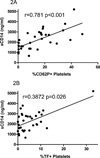Increased platelet and microparticle activation in HIV infection: upregulation of P-selectin and tissue factor expression
- PMID: 22156911
- PMCID: PMC3299881
- DOI: 10.1097/QAI.0b013e3182439355
Increased platelet and microparticle activation in HIV infection: upregulation of P-selectin and tissue factor expression
Abstract
Objective: HIV-1-infected patients have an increased risk for atherothrombosis and cardiovascular disease, but the mechanism behind these risks is poorly understood. We have previously reported that expression of tissue factor (TF) on circulating monocytes is increased in persons with HIV infection and that TF expression is related to immune activation, to levels of HIV in plasma, and to indices of microbial translocation. In this study, we explore the activation state of platelets in HIV disease.
Methods: Here, using flow cytometry-based assays, we measured platelet and platelet microparticle (PMP) activation in samples from HIV-1-infected donors and controls.
Results: Platelets and PMPs from HIV-1-infected patients are activated (as reflected by expression of CD62 P-selectin) and also more frequently expressed the procoagulant TF than did platelets and PMPs obtained from controls. Expression of these proteins was directly related to expression of TF on monocytes, to markers of T-cell activation (CD38 and HLA-DR), and to plasma levels of soluble CD14, the coreceptor for bacterial lipopolysaccharride. Platelet and microparticle expression of TF was not related to plasma levels of HIV but expression of P-selectin was related to plasma levels of HIV; neither TF nor P-selectin expression was related to CD4 T-cell count.
Conclusions: Platelets and microparticles are activated in HIV infection, and this activated phenotype may contribute to the increased risk for cardiovascular and thrombotic events in this population although a role for other confounding cardiovascular risks cannot be completely excluded.
Figures




Similar articles
-
P-selectin- and CD63-exposing platelet microparticles reflect platelet activation in peripheral arterial disease and myocardial infarction.Clin Chem. 2006 Apr;52(4):657-64. doi: 10.1373/clinchem.2005.057414. Epub 2006 Jan 26. Clin Chem. 2006. PMID: 16439610 Clinical Trial.
-
Increased HLA-DR expression on peripheral blood monocytes in subsets of subjects with primary HIV infection is associated with elevated CD4 T-cell apoptosis and CD4 T-cell depletion.J Acquir Immune Defic Syndr. 2002 Jun 1;30(2):146-53. doi: 10.1097/00042560-200206010-00002. J Acquir Immune Defic Syndr. 2002. PMID: 12045676 Clinical Trial.
-
Platelet microparticles and soluble P selectin in peripheral artery disease: relationship to extent of disease and platelet activation markers.Ann Med. 2005;37(1):61-6. doi: 10.1080/07853890410018943. Ann Med. 2005. PMID: 15902848
-
The role of platelets in decrypting monocyte tissue factor.Dis Mon. 2003 Jan;49(1):7-13. doi: 10.1053/shem.2001.29508b. Dis Mon. 2003. PMID: 12525824 Review.
-
The role of platelets in decrypting monocyte tissue factor.Semin Hematol. 2001 Oct;38(4 Suppl 12):2-5. doi: 10.1016/s0037-1963(01)90139-8. Semin Hematol. 2001. PMID: 11735102 Review.
Cited by
-
Inflammasome in platelets: allying coagulation and inflammation in infectious and sterile diseases?Mediators Inflamm. 2015;2015:435783. doi: 10.1155/2015/435783. Epub 2015 Feb 26. Mediators Inflamm. 2015. PMID: 25814789 Free PMC article. Review.
-
A Champion of Host Defense: A Generic Large-Scale Cause for Platelet Dysfunction and Depletion in Infection.Semin Thromb Hemost. 2020 Apr;46(3):302-319. doi: 10.1055/s-0040-1708827. Epub 2020 Apr 12. Semin Thromb Hemost. 2020. PMID: 32279287 Free PMC article. Review.
-
Equid herpesvirus type 1 activates platelets.PLoS One. 2015 Apr 23;10(4):e0122640. doi: 10.1371/journal.pone.0122640. eCollection 2015. PLoS One. 2015. PMID: 25905776 Free PMC article.
-
Cardiovascular Disease and Thrombosis in HIV Infection.Arterioscler Thromb Vasc Biol. 2023 Feb;43(2):175-191. doi: 10.1161/ATVBAHA.122.318232. Epub 2022 Dec 1. Arterioscler Thromb Vasc Biol. 2023. PMID: 36453273 Free PMC article. Review.
-
Soluble CD40 ligand contributes to dendritic cell-mediated T-cell dysfunction in HIV-1 infection.AIDS. 2015 Jul 17;29(11):1287-96. doi: 10.1097/QAD.0000000000000698. AIDS. 2015. PMID: 26091297 Free PMC article.
References
-
- Furie B, Furie BC. Mechanisms of thrombus formation. N Engl J Med. 2008 Aug 28;359(9):938–949. - PubMed
-
- Davi G, Patrono C. Platelet activation and atherothrombosis. N Engl J Med. 2007 Dec 13;357(24):2482–2494. - PubMed
-
- Michelson AD. Antiplatelet therapies for the treatment of cardiovascular disease. Nat Rev Drug Discov. Feb;9(2):154–169. - PubMed
-
- Panes O, Matus V, Saez CG, Quiroga T, Pereira J, Mezzano D. Human platelets synthesize and express functional tissue factor. Blood. 2007 Jun 15;109(12):5242–5250. - PubMed
-
- Jude B, Zawadzki C, Susen S, Corseaux D. Relevance of tissue factor in cardiovascular disease. Arch Mal Coeur Vaiss. 2005 Jun;98(6):667–671. - PubMed
Publication types
MeSH terms
Substances
Grants and funding
LinkOut - more resources
Full Text Sources
Other Literature Sources
Medical
Research Materials
Miscellaneous

